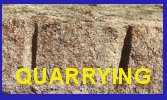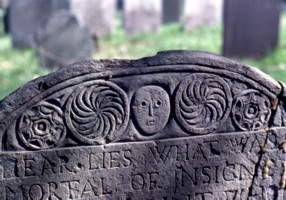



Gravestones
TABLE OF CONTENTS
Field Stone Gravestones
Merrimac Valley style Gravestones
The vast majority of gravestones found in burial grounds were carved by professional gravestone carvers. Occasionally, a grave will be marked by a rough field stone with or without an inscription. To learn more and see some examples please view the Field Stone Gravestones webpage.
Gravestone Rural Folk Art of Northern Essex County, Massachusetts & Examples of Professionally Carved Boston Gravestones found in Essex Co. Gravestones presented carvers a means to express themselves artistically within a defined subject. Furniture makers, silversmiths, potters (ceramics), glass, and pewter makers all used their mediums likewise as a means to express themselves artistically. This was occuring in the late 1600’s and early 1700’s in New England. A period in history generally thought to be devoid of art and decoration. Ironically, it was the Puritans themselves that created this spartan image of themselves. The furniture, silver pieces, ceramics, clothing, and gravestones they left behind tell a radically different story. Both professionally done decorative art and rural folk art flourished during the early colonial period. And, nowhere is this more evident then in gravestone art done by rural carvers.
Gravestones presented carvers a means to express themselves artistically within a defined subject. Furniture makers, silversmiths, potters (ceramics), glass, and pewter makers all used their mediums likewise as a means to express themselves artistically. This was occuring in the late 1600’s and early 1700’s in New England. A period in history generally thought to be devoid of art and decoration. Ironically, it was the Puritans themselves that created this spartan image of themselves. The furniture, silver pieces, ceramics, clothing, and gravestones they left behind tell a radically different story. Both professionally done decorative art and rural folk art flourished during the early colonial period. And, nowhere is this more evident then in gravestone art done by rural carvers.
Boston’s professionally carved slate gravestones made it into Ipswich, Rowley and Newbury burying grounds. These stones had various forms of death symbolism: Father time, crossed bones, complete skeletons, hour glasses, skull and wings, and cherubs. The skull and wings design was the most extensively used design amongst the Boston carvers. These gravestones in turn had an influence on John Hartshorn and the Mullicken family who were rural gravestone carvers in the area. However, both Hartshorn and the Mullickens replaced the skull and wings death symbolism with their own design: an oval mask-like face with either wings or geometric designs flanking either side.
Dating gravestones is sometimes problematic because many were backdated. A lot were ordered years after a person died. However, there is one common factor, prior to 1710 professionally carved Boston gravestones did not have a bottom border or any lines defining the space in which text was carved. Post 1710 all Boston gravestones have the text enclosed either by a bottom border or a line across the bottom. Using this criteria limited dating of designs on Boston gravestones can be discerned. Rural gravestones do not fall into this category. For rural gravestones it is pertinent to have knowledge of each carver individually to be able to date their gravestones
Gravestone art is more than skull and wings or folk art caricature in the top section (lunette). It embodies side and bottom borders, and finials. Border and finial designs with the exception of pumpkin and fig, can be traced to designs found on everyday items like furniture, silver, ceramics and pewter. Cherubs first show up on silver tankards. Vines with leaves and/or flowers in numerous variations were common designs. Elaborate stylized leaf patterns found on silver pieces were also common. Repeated design patterns were standard on furniture (chests and highboys). Every flower and/or geometric design found in gravestone art can also be found on household items.
The vine design found on gravestones has long been considered part of death symbolism. However, the evidence seems to suggest that the gravestone carvers borrowed this design from the artisans who produced various household items. These household objects had no connection with death, they were decorative and cheerful in nature. In light of this information, it seems likely that the various vine designs were simply widely used folk art motifs. The narrow side borders on gravestones offered a decorative space ideally suited to the vine design.
Gravestones were in the public sphere and therefore were public art. They were one of two types of public art accepted in colonial New England. Sign boards for businesses being the other. Burying grounds were beside meeting houses and constantly in the presence of everyone attending service. Stone grave markers (gravestones) stood out from wooden markers. Gravestones were an indication of a family’s wealth and social status. In essence, gravestones from the earliest stones onward were status symbols.
Irregardless of death symbolism or folk art creations, gravestones and gravestone art were used to make certain people standout. The high social and economic status of certain individuals was acknowledged using several different methods: (1) size of the gravestone, (2) the amount and sophistication of the art, and (3) the use of certain folk art motifs restricted to high status individuals. Men and women alike were set apart from their peers. The gender of the person was not an issue when it change to social stauts.
A good example of this occurs in Sawyer’s Burying Ground, Newburyport, MA. In 1708 Ann Chase, Mary Sawyer and Mary Bailey all died. The burying ground as noted was named after the Sawyer family. Ann Chase was given a Boston carved gravestone of unusual status. It is the most elaborate and largest gravestone of its kind in the whole town of Newbury for the time period. (see photo) This stone is far more elaborate than other stones for men. A rural gravestone carver, John Hartshorn carved both Mary Bailey’s and Mary Sawyer’s gravestones. Mary Bailey got an ordinary headstone and footstone.(see photos) Mary Sawyer was the first person in the Sawyer family to die and be buried in the burying ground named after her family. For her Hartshorn made a special effort. Her headstone is a one of a kind creation and is extremely elaborate. At the bottom of each side border is a heart. Her footstone was what made a lasting impression. Hartshorn recreated on a smaller scale a replica of Colonel Pierce’s six foot long slab with a fleur-de-lis in each top corner. (see photos) This set of stones made it known who was the most important woman buried in the Sawyer Burying Ground.
History portrays colonial women as second class citizens. In some geographical areas burying grounds suggest otherwise. A high percentage of women were given gravestones. In a number of instances women were the first people in burying grounds to receive gravestones. Of John Hartshorn’s four oldest gravestones to survive from ca 1700 three have woman’s names. The fourth gravestone is missing the name. Joseph Mullicken who carved from 1736 to 1760 in Bradford, MA, from the mid 1740’s onward gave every woman either hair or a bonnet on top of the face in the lunette. This made his woman’s gravestones standout. Husbands and gravestone carvers alike had respect for women. For more on what men thought about colonial women and how they related to them, at least in Essex County, see Stories Carved in Stone.
Rural gravestone art in Essex County, Massachusetts as a rule did not embody skull and wing imagery. A mask-like face surrounded by fancy lines or circles with geometric designs made up their designs. These rural carvers had the ability to carve skulls but did not. Two were done by one carver in 1722 and never used again by him. An order written in 1784 for a gravestone by a reverend for his wife, sheds some light on the subject, “You will ingrave this in the order as it stands, without a deaths head.” The order came from a professor at Dartmouth College in New Hampshire. Some patrons of gravestone carvers clearly did not want the skull and wings design.
Another interesting facet of gravestone art, it was never static. Rural or professional designs were constantly changing designs. Hartshorn and the Mullicken family of carvers did not make any two gravestones alike. There was a great deal of individualism in carvers art work even though both groups kept within restricted parameters of either skull and wings, cherub or the Merrimac Valley Style mask like face.
Stone markers whether gravestones, select milestones (see milestones) or carved doorsteps (see Stories Carved in Stone) from the 1600’s through the 1700’s were symbols of wealth. They show cased individuals and families, and their status in a community. A tour of milestones and other non-gravestone carvings by these carvers can be found here: tour. The Rev. Ralph Tucker’s unpublished manuscript “Overview of Essex County Gravestone Carvers” (1989) is another great resource.
Examples of Boston Gravestones and Their Art
John Hartshorn, Gravestone Carver
Robert Mullicken Sr, Gravestone Carver
Robert Mullicken Jr., Gravestone Carver
John Mullicken, Gravestone Carver
Joseph Mullicken, Gravestone Carver
Gravestones Honoring Colonial Women
Conclusion
The gravestone carvers highlighted here were part of a larger research project. The rural carvers also carved Newbury’s milestones and a collection of private doorstones (doorsteps) for the Dummer Family. The milestones and doorstones are representative of the first one hundred years in Newbury, Massachusetts from 1636 to 1735.
Gravestones can enlighten us about different communities. A town with all death heads (skull and wings) suggests it was conservative. Towns like Ipswich, Rowley and Newbury with their variety of art, numerous gravestones for women and children suggest a liberal minded community. Gravestones whether elite or ordinary stood out from wooden markers and were status symbols. Women and men alike were given elite gravestones in these towns.
This was a limited study confined to five towns and to select gravestones in reference to the research project. Information garnered during the project started to made the authors question some of the long standing theories held about the colonial period. Other information gained from court records and used in their book also suggests some common held theories are out of date.
To learn more about milestones and how some were used to make public statements, men’s views about women who they respected and honored, and how one family used decorated doorstones (doorsteps) to acknowledge every member in the family, including a woman, who reigned on the Dummer farm read Stories Carved in Stone.

